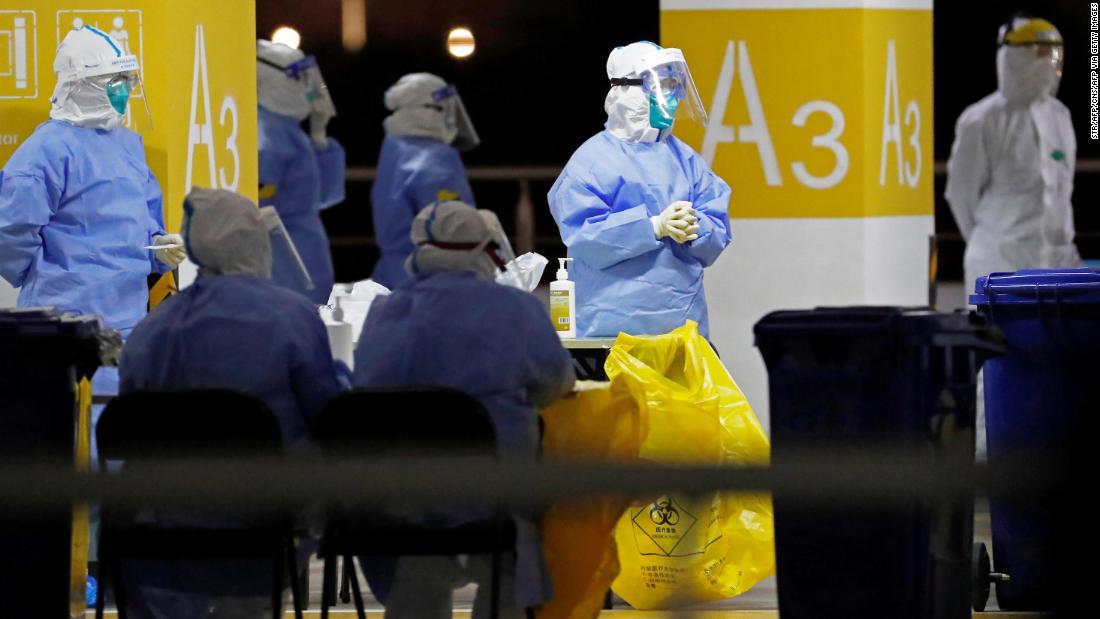Shanghai airport momentarily descends into chaos after workers test positive for Covid-19
Since the start of November, seven cargo workers and their shut contacts on the Shanghai Pudong International Airport have been identified as confirmed coronavirus instances, together with two reported on Sunday.
In a bid to comprise the cluster, authorities ordered all cargo workers on the airport to endure coronavirus exams in a single day and arrange a short lived testing website on the second flooring of a parking storage, in accordance with a press release from the Shanghai authorities.
As of Monday morning, 17,719 samples had been collected. Of the 11,544 samples which were examined, all obtained unfavorable outcomes, officers stated at a information convention.
While the preliminary chaos has drawn criticism on Chinese social media, the swift, drastic response over just some instances highlights the size the Chinese authorities is keen to go to in an effort to stamp out any resurgence of the virus.
China’s zero-tolerance strategy is in stark distinction to the United States, which is struggling to deal with its largest wave of infections because the pandemic started. Contact tracing appears nearly not possible, with each day new instances above 100,000 for three straight weeks.
Trump was noticed at his golf course outdoors of Washington, DC, whereas world leaders together with French President Emmanuel Macron, German Chancellor Angela Merkel, and South Korean President Moon Jae-in mentioned international responses to the virus and how one can enhance pandemic preparedness.
Zero-tolerance strategy
In China, a number of cities have reported new coronavirus instances over the previous week — and all have been met with fast motion from authorities, from intensive testing and call tracing to partial lockdowns.
In the port metropolis of Tianjin, some 600 miles (965 kilometers) from Shanghai, authorities are testing 2.6 million residents in a single district after reporting 5 domestically transmitted instances on Friday, the Tianjin Health Commission stated in a press release.
The mass testing, which began on Saturday, will cowl all residents dwelling within the Binhai New Area district, and is anticipated to be accomplished in three days.
As of Sunday night, Tianjin has obtained greater than 2.25 million test samples, of which over 1 million have come again unfavorable, the well being fee stated.
Manzhouli’s important practice station has suspended operations, whereas its airport has halted all switch flights to the regional capital of Hohhot. Schools are suspended, mass gatherings are banned, and non-essential companies are closed, in accordance with the town authorities.
While these measures have grow to be a typical response to new outbreaks in China, different governments have to date appeared reluctant to introduce related measures.
In Hong Kong, the native authorities tried to roll out city-wide testing for its 7 million residents throughout its third wave of infections in September. In the top, just one.7 million individuals confirmed up for the two-week testing drive.
As the town faces one other surge in coronavirus instances, Health Secretary Sophia Chan stated on Sunday the federal government will give a HK$5,000 ($645) handout to anybody within the metropolis who exams positive to encourage individuals to endure testing.
Second wave
As the winter approaches, nations in Asia have additionally confronted a second wave of coronavirus. While most can be unlikely to undertake China’s zero-tolerance strategy, many have tightened restrictions to sluggish its unfold.
In Japan, each day coronavirus instances have surpassed 2,000 for 5 days in a row. Amid surging instances, the nation’s Prime Minster Yoshihide Suga introduced final week that the federal government’s journey and eating promotion program can be halted in coronavirus hotspots to curb additional infections.
On Monday, South Korea declared an “emergency period” within the capital metropolis of Seoul till the top of the yr, on account of a spike in Covid-19 instances, in accordance with the town’s performing mayor Seo Jung-hyup.
Under the announcement, public transportation will cut back capability by 20% after 10 p.m. and gatherings of greater than 10 individuals can be banned. The metropolis may also conduct common coronavirus exams on some 40,000 workers and customers of nursing hospitals and daycare facilities.
The measures come after a collection of recent restrictions had been introduced for Seoul on Sunday, together with necessary masks carrying indoors and closures of leisure services reminiscent of golf equipment. Restaurants are solely allowed to do deliveries and takeout after 9 p.m., gatherings can be restricted to 100 individuals, and faculties should function at one-third capability.





